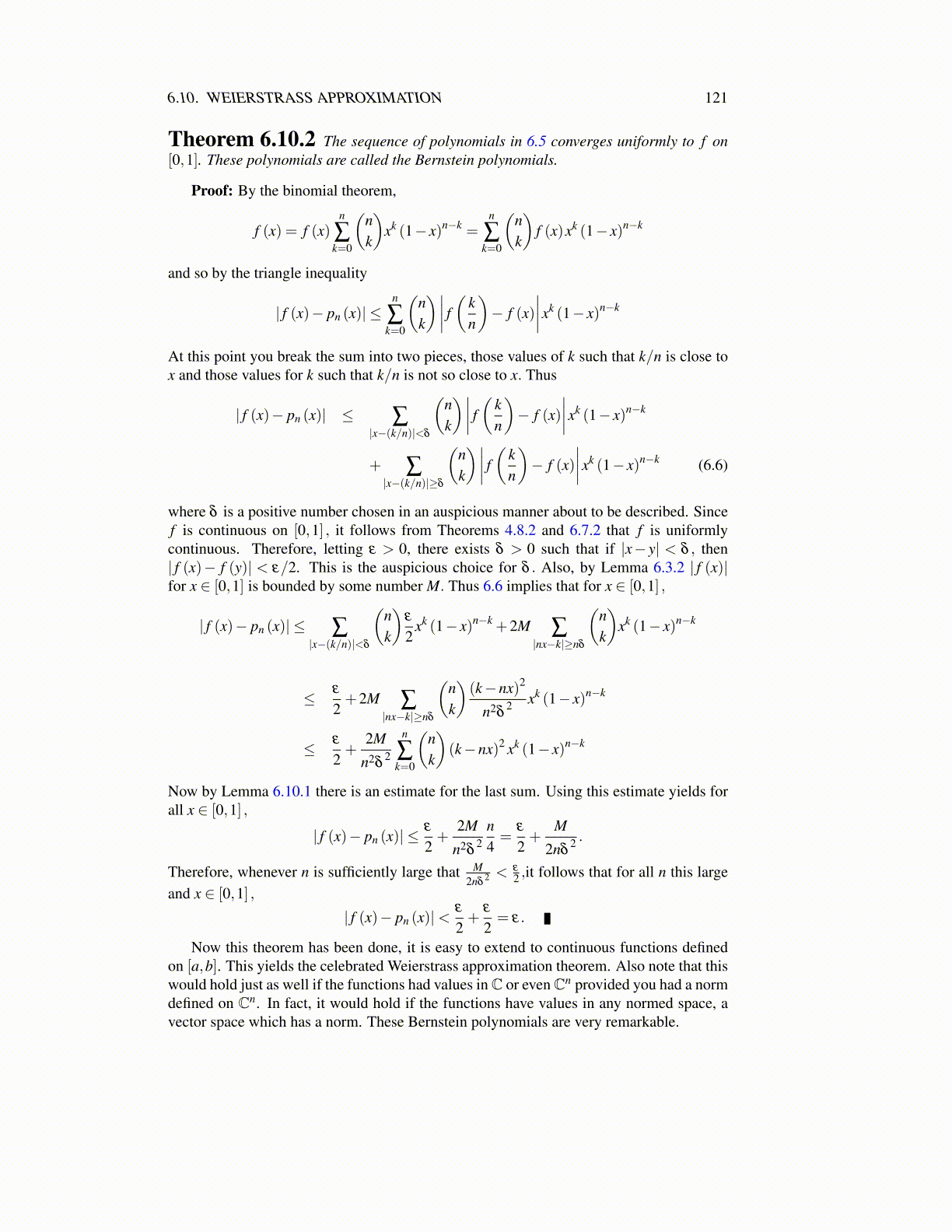
6.11. ASCOLI ARZELA THEOREM 121
last of these subsequences. Thus for each xi of these equally spaced points of the interval,limk→∞ fk (xi) converges. Thus there exists m such that if k, l ≥ m, then for each of thesexi, i = 1, ...,n,
| fk (xi)− fl (xi)|<ε
4Let x ∈ [0,T ] be arbitrary. Then there is xi such that xi ≤ x < xi+1. Hence, for k, l ≥ m,
| fk (x)− fl (x)| ≤ | fk (x)− fk (xi)|+ | fk (xi)− fl (xi)|+ | fl (xi)− fl (x)|
By the assumption of equicontinuity, this implies
| fk (x)− fl (x)| ≤ | fk (x)− fk (xi)|+ | fk (xi)− fl (xi)|+ | fl (xi)− fl (x)|
<ε
4+
ε
4+
ε
4< ε
This has shown that for every ε > 0 there exists a subsequence { fk} with the property thatsupx∈[0,T ] | fk (x)− fl (x)|< ε provided k, l are large enough. The argument also applies withno change to a given subsequence in place of the original sequence of functions. That is,for any subsequence of the original one, there is a further subsequence which satisfies theabove condition. In what follows { fik}∞
k=1 will denote a subsequence of{
f(i−1)k}∞
k=1 . Letε i = 1/2i so that limi→∞ ε i = 0. Then let { fik}∞
k=1 denote a subsequence which correspondsto ε i in the above construction. Consider the following diagram.
f11, f12, f13, f14, · · ·f21, f22, f23, f24, · · ·f31, f32, f33, f34, · · ·
...
The Cantor diagonal sequence is fk = fkk in the above. That is, it is the sequence
f11, f22, f33, f44, · · ·
Then from the construction, f j, f j+1, f j+2, · · · is a subsequence of{
f jk}∞
k=1 . Therefore,there exists m such that k, l > m,
supx∈[0,T ]
| fk (x)− fl (x)|< ε j
However, these ε j converge to 0 and this shows that the diagonal sequence{
f j}∞
j=1 justdescribed is a uniformly Cauchy sequence.
The process of obtaining this subsequence is called the Cantor diagonal process andoccurs in other situations.
From this follows an easy corollary.
Corollary 6.11.3 Let { fn}∞
n=1 ⊆C ([0,T ]) be uniformly bounded and equicontinuous.Then there exists a subsequence which converges uniformly to a continuous function fdefined on [0,T ].
Proof: From Theorem 6.9.11 the uniformly Cauchy subsequence from the AscoliArzela theorem above converges uniformly to a function f . Now by Theorem 6.9.7, thisfunction f is also continuous because, by this theorem, uniform convergence takes conti-nuity with it and imparts it to the limit function.
This theorem and corollary are major results in the theory of differential equations.There are also infinite dimensional generalizations which have had great usefulness in thetheory of nonlinear partial differential equations.